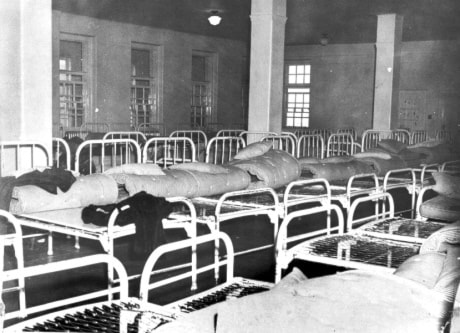One of the most outstanding and vital milestones of our community and province was realized with the completion of the Provincial Mental Hospital (now Centennial Centre) near Ponoka in 1911. This massive modern psychiatric treatment centre would quickly become recognized as one of the finest in North America, but with every successful venture there will always be growing pains.
As new treatment methods, qualified staff and vital equipment were slowly being put into place at the new hospital, the admittance rate would rapidly increase in those beginning years, going from 164 men and women in the first month to more than 1,600 patients under the care of 450 staff by the late 1940s. During the Depression years, construction of much needed hospital buildings was put on hold, the existing buildings became taxed to the limit and run down, while staff numbers were kept at a minimum until after the war years.
The new look of the 1950s
Despite these stressful situations at the PMH, the hospital staff always strived to provide each and every patient with the best of treatment and care, while administration constantly lobbied the government for more funding for additions and improved conditions. With the tremendous demands on the hospital during those initial 40 years, most of the ward dormitories had become bleak and overcrowded, and changes were desperately needed to assure the ongoing wellness of the patients, as well as a better environment in which the staff could achieve their daily duties and vital goals.
In the gala 1961 special section of the Ponoka Herald saluting the 50th anniversary of the Provincial Mental Hospital, Michael Rainone Sr., recreation therapist and newsletter editor, filed the following story, outlining the near completion of the extensive renovations that had begun in January of 1959.
As part of the overall plan to improve accommodation at the Provincial Mental Hospital, Ponoka, many renovations have taken place in the past few years. The changes were undertaken, not to increase the population of the hospital, but rather to bring about more adequate facilities with extended use through modernization of the present buildings, which would serve as an aid to better treatment and hopefully assist the patients to be discharged and get on with their lives.
A great step was taken in this exciting plan with the building of Eastview and Dawnview, two modern men’s wards, which allowed the early brick building, known as Male 4, to be completely stripped inside and rebuilt with every modern amenity needed to improve conditions for the patients who would reside there in the future. A beautiful park replaced the old airing courts, the refurbished bright and cheerful block was renamed ‘Parkside’ and also included a hospital library, beautician shop, games room, canteen, and spacious dining hall.
Through these much-needed changes it was then possible to move some patients from the perennially overcrowded Ladies wards of 4, 5, 6, which were also scheduled to be completely renovated from top to bottom. All of these well-planned additions to the north and west end would also include large lounges and day rooms that featured more windows to attract the welcome sunlight, and allow a grand view of the surrounding prairie countryside. Gone would be the dorm rooms that previously held up to 100 beds, and where the staff literally had to crawl across the top to make them or tend to the patient. The new bedroom areas now include bright and well-furnished single and double rooms, as well as small units of only ten beds.
There would eventually be no more dark and depressing cell-like iron side rooms, and the new cheerful décor would also include plants, piped in music, comfortable and cosy sitting rooms with fireplaces, and a small stage to host entertainment and activities. Another exciting addition to the ‘new look’ PMH wards included modern kitchens on every floor, which featured furniture and modern appliances that would thrill the most ardent housewife. While the work was underway many of the patients were transferred to Deer Home and Claresholm Hospitals, and when they returned home on March 21, 1961, they, along with staff and visitors, were completely overwhelmed by their new home away from home.
The article closed by expressing that with this exciting transformation at the hospital, along with the constant advances being made in medicine and treatment methods, and a better public understanding toward mental health, that we can all now hopefully look forward to a brighter and happier future for those who may become mentally ill.
Now 50 long years later, as the Centennial Centre for Mental Health and Brain Injury proudly celebrates its 100th anniversary, many ongoing changes and improvements have certainly continued to be promoted along the way in all areas of treatment, facilities, décor and staffing. But right from the beginning, the ultimate goal of compassionate care, treatment, and a bright future for the patients have and always will be front and centre.
